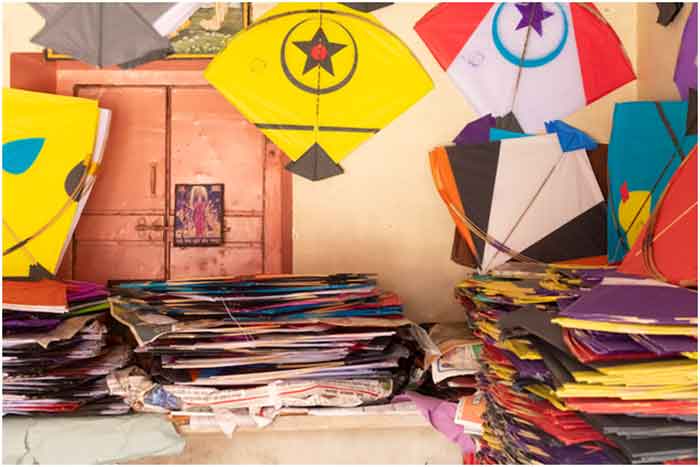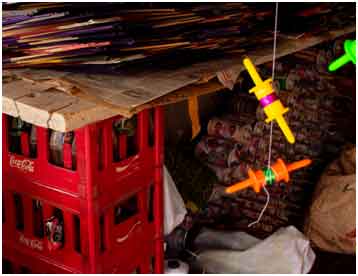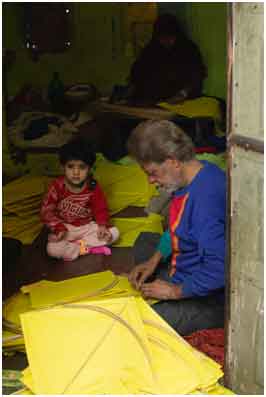
Sitting inside a 4×6 feet room of her house, situated in Jaipur’s walled city, Afrooza Bano is busy carving the notches on bamboo sticks used to make kites. It’s mid-day and she has almost finished making 500 kites and is still to make 500 more. While she is strings the bamboo sticks together, her husband arranges them in a pile.
Despite the Covid pandemic affecting their business thousands of Muslim families in Jaipur’s old city are busy making kites for Makar Sankranti, celebrated around mid-January every year and among the most colourful and vibrant festivals of the country. A week before and after Makar Sankranti the skies of the Pink City are dotted with colourful kites and lanterns as the city celebrates the festival, when farmers pray for a bountiful harvest and prosperous days ahead.
” I start making kites right after my morning tea, taking small breaks in between for household chores. But usually, by 8 PM I almost finish completing 1000 kites”, Afrooza Bano told Covid Response Watch. Afrooza Bano (52) has been making kites for the past 32 years since she got married to Maqbool Ahmed (55). She learnt the skill of kite making from her mother-in-law.
Like Afrooza, dozens of women living in Handipora, Patang Walon Ka Rasta and Haldiyon Ka Raasta localities of Jaipur earn their livelihood by making kites every day. On average a woman makes around 600-1000 kites a day. They mostly do it alone but occasionally family members or grandchildren extend their help.
Depending on the number of kites they make per day, their remunerations also vary from Rs 150- Rs200. Mostly, the women make around Rs 4000-Rs 6000 per month, depending on the season and the amount of work. However, from the last two years, due to the pandemic, their work and livelihood both have been suffered.
x” Right now, there is the demand in the market due to the festival and later we will be exporting kites to different cities. Before the Covid-19 outbreak, for 8-9 months a year we used to have enough work. But our work has been disrupted due to lockdowns and the pandemic situation. We not only lost our livelihood in the last two years but also suffered a lot mentally and economically”, said Afrooza.
 According to the historians, kite flying tradition in Pink City was brought from Uttar Pradesh. Kite flying was made popular by Maharaja Sawai Ram Singh I, a former Maharaja of Jaipur, a keen patron of kite flyers in a town famous worldwide for its rich history of royal accounts. When he was king of Jaipur in (1835-1880 AD) he brought the tradition of kite flying from Lucknow to Jaipur during his tenure. He invited all types of kite-makers to the Pink City and rehabilitated them giving them a market of their own.
According to the historians, kite flying tradition in Pink City was brought from Uttar Pradesh. Kite flying was made popular by Maharaja Sawai Ram Singh I, a former Maharaja of Jaipur, a keen patron of kite flyers in a town famous worldwide for its rich history of royal accounts. When he was king of Jaipur in (1835-1880 AD) he brought the tradition of kite flying from Lucknow to Jaipur during his tenure. He invited all types of kite-makers to the Pink City and rehabilitated them giving them a market of their own.
Due to the pandemic however, the kite selling business has gone downhill. This year also, with a rise in Covid cases, government has put a ban on public gatherings at many places and hence the demand is low.
‘My wife alone used to earn around Rs 6000 per month and her earnings would help us to sustain economically. We are a family of eight members and only three of us earn through daily wage work. My son and I are daily wage labourers and there was hardly any work during the last two years”, Afrooza’s husband Maqbool Ahmed, who works as a labourer in a gem factory said.
 After losing jobs both father and son had to sit at home. However, it was only Afrooza who kept on working and economically helping her family to survive. ‘At one point in time, we literally had to skip meals to survive. When there was no work, we kept making kites and helped her. But again, there was slow demand. But we were hopeful that things will start picking up again”, added Maqbool who even now helps his wife every evening after he returns home.
After losing jobs both father and son had to sit at home. However, it was only Afrooza who kept on working and economically helping her family to survive. ‘At one point in time, we literally had to skip meals to survive. When there was no work, we kept making kites and helped her. But again, there was slow demand. But we were hopeful that things will start picking up again”, added Maqbool who even now helps his wife every evening after he returns home.
As far as the kite business is concerned the slump in the market is witnessed by both sellers and makers. “Two years ago, Jaipur used to witness truckloads of kites coming from Bareilly and Rampur. We even used to have kite makers coming from there staying here for two months. They used to rent out shops and sell their stuff. But now there are hardly any kite makers coming from other cities”, said Irshad Ahmed a kite seller who owns a shop in Patang Walon Ka Rasta.
As per Irshad, kite sales have gone down because of two reasons. Firstly, the decline in the festive fervor owing to the pandemic and the decrease in the buying capacity per household due to job losses in the last two years.
 Besides the pandemic, the ban issued by the state government on the usage of Chinese thread is another reason behind the ban. Owing to the ban, the local thread, called manjha, has become costly. A manjha roll of 3,000 metres thread is priced between Rs 300 and Rs 500 and a roll with 6,000 metres to 12,000 metres thread is sold between Rs 800 to Rs 1,200.
Besides the pandemic, the ban issued by the state government on the usage of Chinese thread is another reason behind the ban. Owing to the ban, the local thread, called manjha, has become costly. A manjha roll of 3,000 metres thread is priced between Rs 300 and Rs 500 and a roll with 6,000 metres to 12,000 metres thread is sold between Rs 800 to Rs 1,200.
“A Jaipuri styled kite is sold somewhere between Rs 5 to Rs 15. The high-end designer ones cost around Rs 25-Rs 50. Similarly, the ones imported from Bareilly are costly as compared to the basic ones”, said Showkat Ahmed who runs a kite shop every year between December to February.
“In the summer months I sell cold drinks and ice cream and in winter months I have been selling kites for the last two decades. I used to make a profit of around Rs 20,000 per month by selling kites. But this year so far, I have only sold kites for Rs 5,000 and made zero profit”, added Showkat who owns a shop at Jowhari Bazar of Jaipur.
 Interestingly, even though the business of kite buying has gone down, some passionate kite makers are still making creative stuff. 71-year-old Gafoor Ahmed makes life-size kites of celebrities and politicians inside his one-room workshop in the walled city. This year he made life-size kites with faces of politicians across party lines such as Narendra Modi, Mamata Banerjee, Rahul Gandhi, Akhilesh Yadav and others.
Interestingly, even though the business of kite buying has gone down, some passionate kite makers are still making creative stuff. 71-year-old Gafoor Ahmed makes life-size kites of celebrities and politicians inside his one-room workshop in the walled city. This year he made life-size kites with faces of politicians across party lines such as Narendra Modi, Mamata Banerjee, Rahul Gandhi, Akhilesh Yadav and others.
” I have been making kites for passion. Doesn’t matter if no one buys them. I would still love to make them and include more celebrities and politicians in my collection”, Gafoor said.
Tabeenah Anjum is a senior journalist based in Rajasthan, reporting on politics, gender, human rights, and issues impacting marginalized communities. She tweets @tabeenahanjum
Photo Credits: Anshul Bhandiwal














































